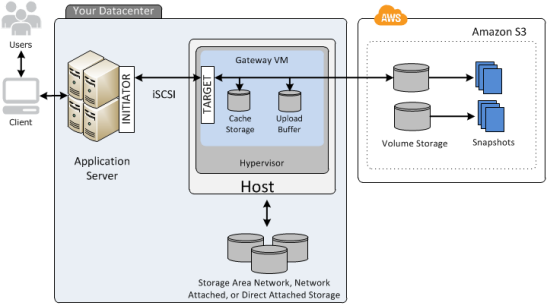AWS News Blog
AWS Storage Gateway – Now Generally Available and New Support for Gateway-Cached Volumes
|
|
The AWS Storage Gateway is a service that connects an on-premises software appliance with cloud-based storage.
We launched the Storage Gateway earlier this year. The initial release supported on-premises iSCSI volume storage (what we call Gateway-Stored volumes), with snapshot backups to the cloud. Volume data stored locally is pushed to Amazon S3, where it is stored in redundant, encrypted form and made available in the form of Elastic Block Storage (EBS) snapshots. When you use this model, the on-premises storage is primary, delivering low-latency access to your entire dataset, and the cloud storage is the backup. Weve seen great pickup of the gateway during the beta, with many customers using the service for cost-effective, durable off-site backup.
We are now adding support for Gateway-Cached volumes. With Gateway-Cached volumes, your storage volume data is stored encrypted in Amazon S3, visible within your enterprise’s network via an iSCSI interface. Recently accessed data is cached on-premises for low-latency local access. You get low-latency access to your active working set, and seamless access to your entire data set stored in Amazon S3.
Each Gateway-Cached volume can store up to 32 TB of data and you can create multiple volumes on each gateway. Cloud storage is consumed only as data is actually written to the volume, and you pay only for what you use. This means that you can use the Gateway-Cached volumes to economically store data sets that grow in size over time, without having to scale your on-premises storage infrastructure. Corporate directory trees, home directories, backup application data, and email archives are often well-suited to this model. Gateway-Cached volumes also provide the ability to take point-in-time snapshots of your volumes in Amazon S3, which you can use to store prior versions of your data. These snapshots are stored as Amazon EBS snapshots.
Here’s a diagram to put all of the pieces together:

You can create and configure new volumes through the AWS Management Console. In addition to specifying the size of each new volume, you also have control over two types of on-premises storage: the upload buffer and the cache storage. Upload buffer is used to buffer your writes to Amazon S3. Cache storage holds your volumes recently accessed data. While the optimal size for each will vary based on your data access pattern, we generally recommend that you have an upload buffer that’s large enough to hold one day’s worth of changed data. If you create an 8 TB volume and change about 5% of it each day, a 400 GB upload buffer should do the trick. The cache storage should be large enough to store your active working set of data and at least as big as the upload buffer.
We are also taking this opportunity to promote the AWS Storage Gateway to General Availability. You can use it to support a number of important data storage scenarios like corporate file sharing, backup, and DR in a manner that seamlessly integrates local and cloud storage.
We’ll be running a free Storage Gateway webinar on December 5th, 2012. You’ll learn how to use the AWS Storage Gateway to backup your data to Amazon S3. You’ll also learn how you can seamlessly store your corporate file shares on Amazon S3, while keeping copies of frequently-accessed files on-premises.
For more information, read What is the AWS Storage Gateway and How the AWS Storage Gateway works
You can get started with the AWS Storage Gateway by taking advantage of our free 60-day trial. After that, there is a charge of $125/month for each activated gateway. Pricing for Gateway-Cached storage starts at $0.125 per gigabyte per month. Register for your free trial and get started today!
— Jeff;
PS – The Storage Gateway team is looking for smart software development engineers at all levels of experience. You will get the opportunity to develop a cloud-based storage service that is changing storage for enterprise customers. Join a team that is smart, driven to serve customers, loves to tackle hard problems and fun to work with, in a start-up like environment. Links to some of our positions are below:
